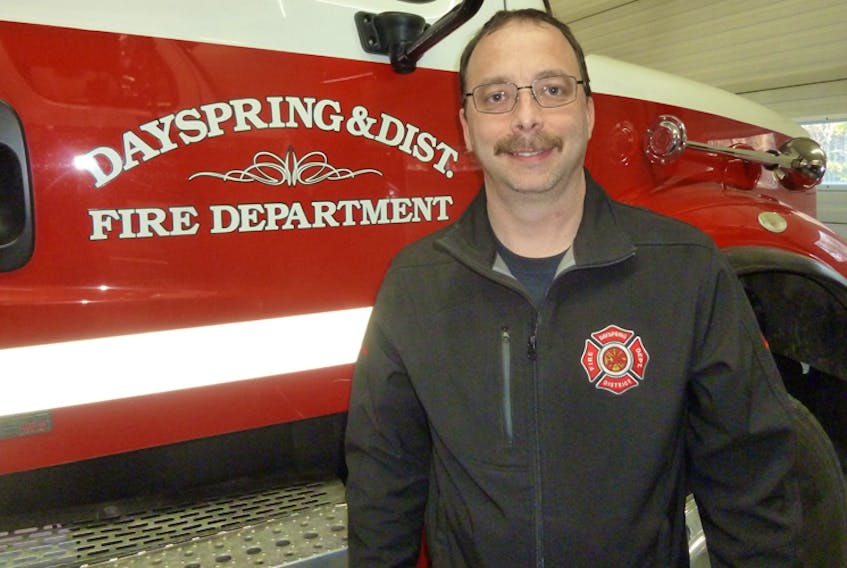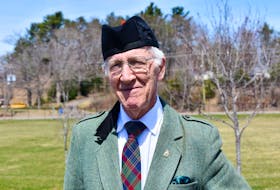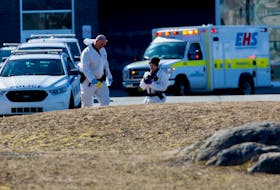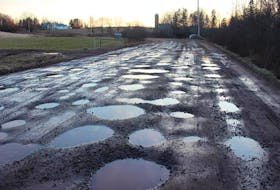Lunenburg County volunteer firefighters were busy in 2017, responding to 1,079 emergency calls, at all hours of the day and night, and during often-challenging weather conditions.
Statistics for 2018 have yet to be released, since it takes a great deal of time to compile the relevant data from the county’s 24 fire departments and associated agencies.
According to Chris Kennedy, fire services co-ordinator for the Municipality of the District of Lunenburg (MODL), medical emergencies accounted for a whopping 38 per cent of calls, followed by mutual aid at 24 per cent and motor vehicle collisions at 13 per cent.
Fire-related emergencies – structure and chimney fires, alarms sounding, propane, trees on power poles, wildland/brush fires, smoke sightings and vehicle fires – accounted for 20 per cent of calls.
Miscellaneous and water-related calls totalled five per cent.
The firefighters and medical first responders who answered those 1,079 calls were all volunteers – men and women who left work, home or recreational pursuits to assist community members in times of urgent need.
I wonder how much it would cost a municipality to provide fire protection and associated services, if there were no volunteers to respond to emergencies. A big crooked number, followed by six zeros, is a fair guess.
Most fire departments grapple with the retention and recruitment of volunteer firefighters. There is a lot of gray hair on the heads of active firefighters these days, as young folks don’t seem to be too eager to volunteer time because they are already struggling to juggle myriad personal commitments. Life happens.
The average age of the top five emergency responders at my local fire department last year was 67. Remove the youngest from this group and the average age of the remaining four top responders rises to 72. All are competent, knowledgeable and professional, but, c’mon, these long-serving guys deserve some down time.
The MODL mayor, council and senior staff recognize a worrisome problem exists and have committed dollars and staff resources to develop a retention-and-recruitment strategy that all fire departments can use.
Last month, MODL communications officer Sarah Kucharski and Kennedy presented the municipality’s Fire Service Volunteer Recruitment and Retention Strategy document to fire service officials for their review and comment. Kucharski and Kennedy will return later this month to gather feedback.
The 18-page document, which was developed by senior municipal staff and the municipality’s Fire and Emergency Services Committee, has received favourable comments from MODL council members.
Once feedback from the fire service has been tabulated, council will review the comments, make any adjustments, and then likely approve the strategy in June. Action on the items could commence as early as July.
“On recruitment, we told firefighters here’s a bucket of things the municipality can commit to do, and here’s a bucket of things you could do yourself,” Kucharski says.
“The same goes for retention strategies.”
The municipality intends to develop a comprehensive and unified menu of marketing materials – including posters, brochures and online social media content – which would be available to all fire departments.
Kucharski says a beefy recruitment package will be distributed to a range of local organizations, and the municipality will also display them in the reception area and on the building permits’ counter.
“Among other things, our marketing campaign will consist of radio and newspaper advertising, articles in our Municipal Matters newsletter, and an annual recruitment newsletter,” Kucharski says.
“And, to create a community presence, municipal officials could possibly team up with firefighters and attend events such as home shows to answer questions from the public about the fire service,” she adds.
Any residents with an interest in becoming volunteer firefighters are encouraged to contact their local fire department. My sense is you will be welcomed with open arms, and be given a pretty sweet helmet to wear.
Paramedic predicament
I opined in this space last month how Nova Scotia’s 1,100 hard-working Emergency Health Services (EHS) paramedics are not afforded the recognition, support and compensation they deserve, and how the patient transfer from paramedics to hospital staff, which by provincial standard is required to occur within 20 minutes of arrival, 90 percent of the time, can drag on for hours, tying up paramedics, ambulances and vital diagnostic equipment.
Meanwhile, rural Nova Scotia seems to take a poor-cousin backseat to HRM. When paramedics complete a patient transfer from a rural hospital to HRM, the crew is often held in the city to handle 911 calls.
A veteran paramedic told me he was fed up having to babysit intoxicated teenagers at a Halifax, hospital when he and his partner could be back in their rural community responding to critical medical emergencies.
Another paramedic said, when he began his career 19 years ago, Nova Scotia paramedics responded to about 300 calls during a 24-hour period, with the numbers occasionally reaching 350 to 400 on busy days.
Today, calls can reach 500 to 600 a day, and have occasionally spiked to 700. Talk about potential burnout.
This is in a province with a population of less than one million people.
Unless something is done to address these constant challenges, the situation will only worsen. After all, the population is aging and health issues are becoming more prominent, and scary, with each passing year.
I’ve been told no one gets into paramedicine for the money. That’s noble, but let’s ensure paramedics are compensated fairly. Currently they are miles behind nurses when it comes to the heft of pay packets.
Here’s what I’m thinking. The provincial government, in collaboration with EHS and other stakeholders, must do whatever it takes to keep our experienced and recently trained young paramedics in Nova Scotia, not lose them to Upper Canada, where lucrative compensation packages and other enticements are there for the taking.
It could very well be a matter of life or death, perhaps involving you or a member of your family.
Peter Simpson is a veteran journalist and former chief executive officer who lives in a rural South Shore community. His often-provocative Here’s What I’m Thinking column appears monthly in the Breaker. He can be reached at [email protected]









